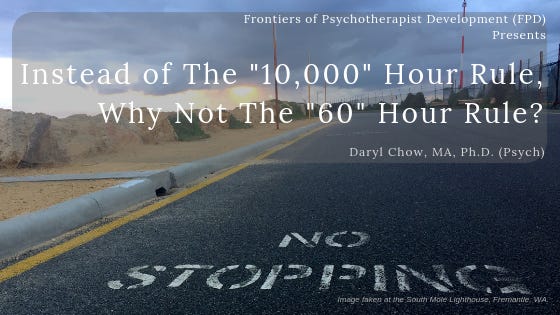Instead of The “10,000” Hour Rule, Why Not The “60” Hour Rule?
Updates by Daryl Chow, MA, Ph.D.(Psych)
View this email in your browser
Instead of The “10,000” Hour Rule, Why Not The “60” Hour Rule?
By Daryl Chow, MA, PhD on Oct 09, 2018 11:14 pm
By now, many of you would have heard about the 10,000-hour rule, made popular by Malcolm Gladwell’s book, The Outlier. This was largely based on K. Anders Ericsson and colleagues seminal work in 1993, studying the effects of deliberate practice on musical performance.
For the record, this 10,000-hour rule is a crude estimate–rather than a rule–based on averages. Clearly, there are folks who take more time, and others, much to our envy, take less time to develop true expertise. (Here’s what we found about the influence of deliberate practice on the development of highly effective psychotherapists).
But here’s another number that doesn’t get talked a lot about: 60 hours.
This is the amount of time the top violinists versus the average performers spent each week resting.
That’s right. Rest.
On average, the top violinists took 5.4 hours more in states of shut-eye. (The amount of time difference that top musicians rested was 60hrs/wk, compared to the average performers of 54.6hrs/wk.)
Not only did the top violinists sleep more (8.6hrs vs 7.8hrs), they also took more snoozes in the afternoon. (I call this “horizontal meditation”).
Why is this important for you as therapists out there in the real world?
We underrate the importance of taking breaks during our clinical practice. Busyness almost always wins. Must this be a perpetual losing battle with time? (see my other blog site Full Circles: Reflections on Living for this article, The One Thing You Can Do to Have More Time)
First, in order to optimise learning, Barbara Oakley stresses the importance of how we need to weave between a focused state and diffused state.
Second, in order to optimise our ability to engage with our clients on a regular basis, we need to see that stress is not the problem a lack of recovery is. (See these blogposts, What Burns You Out and The Brink).
Call to “Non-Action”
Whenever I bring this up to clinicians around the world, I would get a nod of approval, but unless they move to Japan, or work for companies like Nike or Zappos, they do not see it as possible to take breaks during the day.
I would like you to challenge this assumption. You may not need “nap pods,” but you can design periods of “white space” into your day. (Quick: spice up a few 15mins of white-space into your calendar for boredom, mind wandering, or sauntering!). This is critical not only for your ability to learn, stay focused with your clients, but also, take care of your wellbeing.
Today is World Mental Health Day. May we continue to subvert the notion of “mind over body,” but instead, appreciate that our mind is there to take care of our body.
The next time you take a break, remind those around you that you are on the road of expertise, and on this road, routine pitstops are not a luxury but a necessity. If you need a reason beyond “you”, you are doing this much as it is for you, and also for your clients.
Cheers to you and what you do for the people you serve in your local community.
The post Instead of The “10,000” Hour Rule, Why Not The “60” Hour Rule? appeared first on Frontiers of Psychotherapist Development.
Recent Articles:
How Do You Grow as a Clinical Supervisor?
A System of Practice: Creating a Framework To Make Deliberate Practice Happen (The Complete Talk at Achieving Clinical Excellence Conference, Sweden 2018).
Which Way to Go?
Beyond “Case-By-Case” Clinical Supervision
Value What We Measure, or Measure What We Value?







